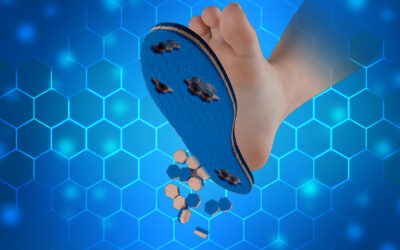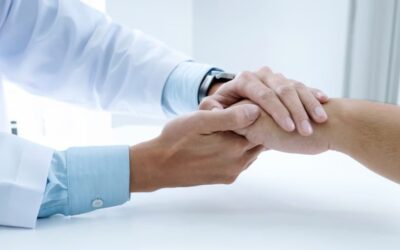Blog
The Latest Treatments for Peripheral Artery Disease (PAD)
Emerging Innovations and Personalized Care Options for 2025 Peripheral Artery Disease (PAD) is a progressive vascular condition marked by reduced blood flow to the lower limbs, resulting in pain, cramping, and chronic wounds that heal slowly. PAD significantly...
Lifestyle Adjustments to Manage Leg Pain and Cramping
Effective Everyday Habits for Vascular and Muscle Health Leg pain and cramping are common issues, especially among adults over the age of 40. While these symptoms may sometimes be harmless, they are often associated with underlying conditions such as Peripheral Artery...
The Link Between Diabetes and Unhealed Foot Wounds
How Diabetes Impacts Foot Ulcer Healing and What You Can Do About It Foot wounds that resist healing are among the most serious and common complications faced by individuals living with diabetes. What may begin as a minor cut, blister, or pressure point can quickly...
Understanding the Different Types of Wounds and Their Treatments
How Proper Diagnosis and Targeted Care Support Faster Healing and Better Outcomes Wounds are more than surface injuries—they often reflect deeper health concerns and require proper classification to ensure appropriate care. In clinical practice, wounds are categorized...
Understanding Different Types of Vascular Wounds
Early Detection and Expert Care for Arterial, Venous, and Mixed Ulcers Vascular wounds are a complex and serious concern, particularly for individuals with underlying circulatory conditions such as peripheral artery disease (PAD) or chronic venous insufficiency (CVI)....
Compression Therapy for Alleviating Leg Swelling
Simple, Non-Invasive Relief for Leg Pain, Swelling, and Fatigue If your legs often feel sore, heavy, or swollen, you’re not alone—and the cause may not be your age or fitness level. In many cases, leg swelling stems from poor circulation or underlying vascular issues...
The Connection Between Calf Pain and Venous Insufficiency
Calf pain is a common condition that can limit mobility and affect daily activities. It may present as a sharp, stabbing sensation or a dull, throbbing ache, often accompanied by muscle tightness, especially during walking or exercise. While many people dismiss calf...
Diabetic Foot Care: Preventing and Treating Toe Ulcers
Diabetes has become one of the fastest-growing vascular conditions worldwide, with cases skyrocketing from 200 million in 1990 to nearly 900 million in 2024, according to the World Health Organization (WHO). Despite the increasing prevalence, less than half of people...
Early Signs of Vascular Disease: What to Look Out For
Vascular disease has become one of the most prevalent health concerns worldwide. According to reports from the World Health Organization (WHO) and the Centers for Disease Control and Prevention (CDC), more people than ever are developing vascular complications. If...
The Importance of Proper Gait to Prevent Pain While Walking
Walking is a fundamental part of daily life, yet many people overlook the importance of maintaining a proper gait to prevent pain and discomfort. Poor walking posture and improper foot mechanics can contribute to lower back pain, joint strain, and even circulation...
Understanding Leg Cramps: From Symptoms to Solutions
Leg cramps are a problem that many people face. They strike anytime and often find you when you are not prepared. These painful, involuntary muscle contractions usually affect the calf muscles, though they can occur in the thighs or feet also. While minor, leg cramps...
Smoking and Peripheral Artery Disease: A Dangerous Combo
Peripheral artery disease, or PAD, is a condition that narrows the blood vessels in your arms or legs. Most people are unaware that smoking plays a huge role in this disease. Several studies have shown that smoking, which causes stiffness and clogs in arteries,...
The Role of Nutrition in Vascular Wound Healing
Proper nutrition plays a very crucial role in the process of wound healing in vascular patients. Poor nutrition can give rise to serious complications, such as slower healing or infection which in turn increases the chances of amputation. Real life cases have...
Stretching and Strengthening Exercises to Prevent Walking Pain
Pain when walking is highly discomforting and can impact your quality of life. It may be a sign of a vascular condition such as peripheral artery disease, claudication, deep vein thrombosis, and diabetes. The pain usually presents in your calves, ankles, thighs or...
How to Keep Your Wounds Clean and Prevent Infections?
While the human body is wonderfully designed to endure all the wear and tear that comes with normal life, we still bear a duty to take care of it. Whether we're working in the most hazardous conditions imaginable or chopping veggies in our kitchens, the possibility of...
The Importance of Offloading in Foot Wound Care
Every 30 seconds around the world, there is an amputation of the lower limb due to diabetic foot ulcers. This staggering report by the American Diabetes Association underscores how proper wound care, particularly offloading is essential to keep most complications at...
How Vascular Health Impacts Leg Pain
Vascular health is key to overall well-being, more so in the health of the legs. Inadequate vascular health resulting in leg pain is likely to influence daily activities and the quality of life as a whole. Recognizing the symptoms of poor vascular health, whether pain...
The Link Between Diabetes and Peripheral Artery Disease
The human body largely consists of intricately woven systems that work in perpetual harmony. At the very core, this is what allows the body to function optimally. Unfortunately, having these divergent yet linked systems can also lead to disease-sharing pathways. The...
How Poor Circulation Contributes to Calf Pain
A considerable percentage of people visit their primary care physicians to report calf pain. This pain affects the back part of the lower leg. Several conditions can cause the pain, with the most common being muscle strains, nerve damage and injuries. Pain in your...
The Stages of Toe Ulcer Healing: What to Expect
Foot ulcers are a major complication of diabetes and peripheral artery disease (PAD). About 30% of people with diabetes develop neurotrophic ulcers at some point. PAD can reduce blood circulation to your extremities, leading to the development of arterial ulcers. The...
The Impact of Lifestyle Choices on Vascular Health
For nearly a century, cardiovascular diseases have been a major cause of health impairment and premature deaths worldwide. Today, considerable progress has been made to manage the multifaceted world of cardiovascular health. Among the most effective strategies...
The Connection Between Obesity and Pain While Walking
Obesity is becoming a rampant issue. According to the CDC, more than 42% of Americans have a body weight in the obese category. That is almost half the population! Other than being. Apart from impacting how you look, obesity can have serious health implications. One...
Effective Exercises for Reducing Leg Swelling
A painful or swollen leg is one of the most uncomfortable feelings you can experience. Not only do you have to deal with the often-accompanying pain, but a swollen leg can keep you from doing even the most basic of tasks. Walking, taking a shower, and exercising are...
How to Prevent Infections in Vascular Wounds
Vascular wounds, particularly those associated with surgical procedures are at a high risk of infection due to their exposure and the nature of the vascular system. Naturally, the vascular system is vast and spreads to a wide network of the body. When one part is...
The Role of Nutrition in Accelerating Wound Healing
As the adage often goes, you are what you eat. While many people know of this famous quote, few people actually think about the impact of their diet on the body. This despite all the available modern research and all the resources at your disposal. So, just what...
Tips for Preventing Foot Wounds from Infections
Vascular complications can affect any part of the body. The feet are particularly vulnerable to a wide number of conditions. Moreover, foot pain and associative wounds are a common progression path for numerous diseases. Foot wounds can be extremely painful and take...
Uncovering the Underlying Causes of Leg Pain and Cramping
Leg pain and cramping can interfere with your daily activities, causing physical discomfort. Leg cramps commonly cause sleep disruption and lead to reduced quality of life, low mood or symptoms of depression. In this article, we will explore the many contributing...
The Early Signs of Peripheral Artery Disease
We all hope to live long and healthy lives, right? Well, a big part of keeping ourselves in top condition is being watchful and figuring out problems before they become too serious. Most medical conditions will show up with a variety of warning signs and symptoms that...
Uncovering the Connection Between Vascular Health and Toe Ulcers
Uncovering the Connection Between Vascular Health and Toe Ulcers Toe amputations are on the rise. Studies show that these minor amputations have a 17.7% chance of leading to major lower limb amputations. Although they appear small, toe ulcers could be signs of...
Exploring Common Causes of Calf Pain
Exploring Common Causes of Calf Pain Calf pain is a musculoskeletal discomfort developed at the backside of the lower leg. The calf consists of 2 muscles, which are known as the gastrocnemius and the soleus. They come together at the Achilles tendon, which is fixed to...
Uncovering Vascular Causes of Walking Pain
Uncovering Vascular Causes of Walking Pain Stability, flexibility, and strength are the primary characteristics of your lower limbs. All these aspects help with walking, which is one of the best activities for optimal health. But what if you experience pain when...
Uncovering the Vascular Causes of Leg Pain and Swelling
Uncovering the Vascular Causes of Leg Pain and Swelling Vascular causes of leg pain and swelling are issues that affect blood vessels in the body's extremities. The vessels, in this case, are the veins and arteries, and when they are not functioning at optimum, they...
Understanding the Different Types of Vascular Diseases
Understanding the Different Types of Vascular Diseases Vascular diseases are those that affect the blood vessels in our body, interfering with normal circulation of blood. Such conditions may result in serious health complications and it’s important to become aware of...
The Basics of Vascular Wound Care
The Basics of Vascular Wound Care: What You Need to Know Vascular wound care is one of the essential services you would get from specialist care. However, there will also be a significant part that requires you to care for the wounds at home, so it helps to know the...
Vascular Wound Treatments
Comprehensive Guide to Vascular Wound Treatments Vascular wounds are lesions resulting from tissue damage in the veins or arteries. These wounds commonly affect the lower limbs including your ankles, calves, and feet, but they can occur elsewhere. There are two main...
The Vascular Connection
The Vascular Connection: How Circulation Affects Foot Wound Healing Wounds on feet are indeed a major issue, especially among diabetic and peripheral vascular diseases patients. Healing involves a range of factors, and one important aspect is circulation. It is the...
Chronic Venous Insufficiency (CIV)
Did you know that if your work involves long hours of sitting, your legs could suffer badly? One of those conditions that affect the legs is chronic venous insufficiency. And the irony is, you can also get it if you spend most of your days standing. The fact is, the...
Arteriovenous Malformations (AVMs)
Arteriovenous malformations refer to faulty connections between the arteries and veins in our bodies. They are typically formed in people’s brains and spinal cords but may occur elsewhere in our bodies. What happens is that instead of oxygenated blood being delivered...
Deep Vein Thrombosis
One of the most common circulatory problems is deep vein thrombosis (DVT). It commonly affects the legs but it can be diagnosed on the arms and pelvis as well. The most recent data suggests that about 30% of patients can succumb if DVT is not diagnosed and treated...
Peripheral Artery Disease (PAD)
Our treatment for Peripheral Artery Disease is minimally invasive, less painful, safer, and offer a lower risk of side effects compared to bypass surgery.Only a tiny needle puncture in the skin is neededRecovery is typically just a couple of daysRate of complications...
Deep Vein Thrombosis
Deep vein thrombosis happens when a blood clot forms a vein found deep in the body, usually in the legs or the pelvis. Besides the discomfort and pain it may cause in the affected area, there is a huge risk of complications, including pulmonary embolism. That may...
Critical Limb Ischemia
Critical Limb Ischemia If you or someone you know is exhibiting symptoms of critical limb ischemia, it is crucial to get medical intervention immediately. This is because CLI is a grave medical condition that can adversely affect the flow of blood to the limbs. If...
Chronic Venous Insufficiency
Chronic Venous Insufficiency Chronic Venous Insufficiency (CVI) happens when the functioning of the venous wells and or the valves in the leg veins is damaged. As a result, blood does not flow back to the heart from the legs. In normal circumstances, there is...
Pulmonary Embolism
One in every 1000 Americans suffers from pulmonary embolism (PE). Pulmonary embolism happens when a blood clot lodges in one of the pulmonary arteries in the lungs. The blood clot develops in another part of your body and then travels to the lungs during blood...
Vascular Disease
Even if we had millions of dollars in the bank, there would never be anything more important in our lives than our health and that of our loved ones. This is why choosing the right medical practitioner to take care of us is such a critical decision. This applies to...
Pulmonary Embolism
Pulmonary Embolism is when the pulmonary arteries suddenly block, and blood flow to the lungs experiences difficulties. The condition usually results from a blood clot in your leg's deeper vein breaking off and traveling to the lungs. So the term embolus refers to...
Carotid Artery Disease (CAD)
Carotid Artery Disease is a blood clot that affects major blood vessels along the neck region. Thecarotid arteries, which transport oxygen-rich blood to the brain, start to narrow or even getblocked. This might be because of a buildup of fatty deposits in your body...
Peripheral Artery Disease
Peripheral Artery Disease Cramping, pain, or tiredness in your legs that goes away when walking may indicate peripheral artery disease (PAD). Mubashar Choudry, MD, provides the latest in PAD diagnosis and treatment at his offices in Washington Vascular Specialists in...
Arteriovenous Malformation
Management and Treatment of Arteriovenous Malformation The body is one of the greatest masterpieces. While it has some vulnerabilities, the body is masterfully crafted. Blood vessels are a stellar example of the intricate workings of the body. These vessels move blood...
Abdominal Aneurysms
What are Abdominal aneurysms? The body’s circulatory system is one of the most intricate and complex structures in the human body. The system is highly calibrated for efficiency at all times. Nonetheless, this circulatory system may be susceptible to various attacks...
Critical Limb Ischemia
Critical Limb Ischemia (CLIT) Critical Limb Threatening Ischemia manifests by severe foot pain, limited blood flow to lower limbs, and wounds that don’t heal. The team at Washington Vascular Specialists has perfected approaches for diagnosing, treating, and caring for...
Chronic Venous Insufficiency (CIV)
An increasing number of professions require workers to stand for a long time. You have a higher risk of developing chronic venous insufficiency if you stand for long periods. Here is what happens -blood pools and cuts back venous return. The result is a buildup of...
Arteriovenous Malformations (AVM)
Veins and arteries ship oxygen back and forth between the heart and the lungs through blood. If you have an arteriovenous malformation, this process becomes impaired. That means that your cells and tissues may not get enough oxygen. Also, the affected AVM blood...
Varicose Veins
Varicose Veins: Causes, Risk Factors, and Treatments Varicose veins, varicosities, or varicose refer to the condition whereby the veins in a person’s legs become overly dilated or enlarged, making them less efficient at transporting blood up and down our limbs. The...
Carotid Artery Disease
Carotid Artery Disease Management And Treatment Understanding the causation and progression process of a disease gives you the best chance to combat it. Carotid artery disease is a serious vascular illness that can affect anyone. This vascular condition can greatly...
Deep Vein Thrombosis
Deep vein thrombosis (DVT) is a condition in which a blood clot lodges in the body's deep veins. It usually occurs in the legs but can also develop in other areas, such as the pelvis and arms. CDC data shows that DVT kills 10-30 % of patients within a month of...
Chronic Venous Insufficiency
Outline Chronic venous insufficiency (CVI) is a medical condition in which the leg veins get damaged and struggle to return the blood to the heart. The valves in the veins fail to function correctly and prevent the backflow of blood, resulting in the need for more...
Peripheral Artery Disease
Risk Factors, Symptoms, and Management Peripheral artery disease, commonly referred to as PAD, is a condition characterized by the accumulation of cholesterol and fats (plaque) in the arteries in a person’s arms and legs. This accumulation leads to blockages in blood...
Pulmonary Embolism
Approximately 900,000 people in the U.S. get diagnosed with pulmonary embolism (PE) each year, which results from a blockage in the main artery of the legs. PE is a life-threatening condition that can cause sudden death. This blog will explain what to expect if...
Deep Vein Thrombosis
Deep Vein Thrombosis Deep vein thrombosis (DVT) is a blood clot in one of the deep veins in your body. Deep veins are closer to your heart than the superficial veins you can see on the surface of your skin. The two most common places for DVT are in your leg or arm....
Pulmonary Embolism
Pulmonary Embolism Pulmonary embolism is when one or more clots block the main artery leading to the lungs. It can be fatal if untreated, but medication is often treatable. This article will explain pulmonary embolism and how it's diagnosed and treated.What is...
Varicose Vein
Varicose Vein Varicose veins are a condition that occurs when the valves in your veins become weak, allowing blood to pool in the vein and stretch it out. This causes a bulge to develop on the surface of your skin. The most common areas affected are your legs and...
Abdominal Aneurysm
Abdominal Aneurysm An abdominal aneurysm is a bulge in the wall of your aorta, the main blood vessel that carries oxygen-rich blood from the heart. It can be caused by abdominal trauma or may happen spontaneously over time. Abdominal aneurysms can rupture suddenly and...
Vascular Disease
Vascular Disease From elementary science, you understand that your body's primary transport system is your blood vessels. They carry blood rich in oxygen and other nutrients to different body parts. It follows then that blood vessels are vital to optimal health, and...
Peripheral Artery Disease (PAD)
Peripheral Artery Disease is a disease in which the buildup of plaque occurs in the arteries that carry oxygenated blood to your head, limbs and other organs. It is the most common of the peripheral vascular diseases (diseases of blood vessels outside of the brain...
Critical Limb Ischemia
Critical Limb Ischemia Limb Ischemia is a condition that can affect a person's limbs and is characterized by a narrowing of the arteries that supply nutrients and oxygen to the limb in question. This may result in eventual tissue death if left untreated. It is...
Arteriovenous Malformation (AVM)
Arteriovenous Malformation (AVM) Arteriovenous malformation (AVM) is a tangle of abnormal and poorly formed blood vessels, primarily veins, linking arteries, and veins. AVMs usually develop in the brain or spinal cord but can also occur in other areas of the body. The...
Peripheral Artery Disease (PAD)
Our treatment for Peripheral Artery Disease is minimally invasive, less painful, safer, and offer a lower risk of side effects compared to bypass surgery.Only a tiny needle puncture in the skin is neededRecovery is typically just a couple of daysRate of complications...
Carotid Artery Disease
What is carotid artery disease Carotid artery disease happens when fatty deposits fill the blood vessels that carry blood to the head and the brain. As a result of the blockage, the blood flow to the brain is interrupted, increasing the risk of a stroke. A stroke cuts...
Chronic Venous Insufficiency
Chronic Venous Insufficiency: Symptoms, Causes, and Treatments Due to various factors and conditions, the human body eventually tends to encounter difficulties and might fail us in some ways. Thankfully, our medical sciences are continuously evolving and innovating to...
Pulmonary Embolism
One in every 1000 Americans suffers from pulmonary embolism (PE). Pulmonary embolism happens when a blood clot lodges in one of the pulmonary arteries in the lungs. The blood clot develops in another part of your body and then travels to the lungs during blood...
Vascular Disease
Even if we had millions of dollars in the bank, there would never be anything more important in our lives than our health and that of our loved ones. This is why choosing the right medical practitioner to take care of us is such a critical decision. This applies to...
Varicose Veins
Varicose Veins can occur anywhere on the body but they are often found in the legs and feet. Varicose Veins appear as dark purple or blue and are bulging or lumped up and twisted in their appearance. Varicose veins appear to be a common occurrence affecting about 25...
Abdominal Aortic Aneurysm
As the major blood vessel, the aorta transports blood from your heart down through your chest and into your abdominal area. Your aorta has numerous branches that carry blood to your major organs and other body parts. It divides around your abdominal area into your leg...
What Are Arteriovenous Malformations?
The circulatory system is perhaps one of the most complex networks in the human body. This system is made up of the heart, blood vessels, blood, lymph, glands, and lymphatic vessels. The circulatory system is majorly responsible for transporting lymph and blood to all...
What Is PAD, And How Is It Treated?
The importance of blood reaching all body parts cannot be overstated. Without a regular supply of oxygenated blood, various body parts will not function effectively. The limbs are especially susceptible to receiving less blood. This can lead to a vascular condition...
Deep Vein Thrombosis (DVT)
Deep vein thrombosis (DVT) refers to blood clots in deep veins. When a deep vein clot breaks, it can travel up the bloodstream and lodge in the lungs, blocking blood flow (pulmonary embolism). DVT mostly occurs in the thighs or lower leg areas.What is deep vein...
What is Critical Limb T. Ischemia?
Critical limb-threatening ischemia (CLTI) is a severe form of peripheral artery disease in which blood flow to the legs is severely restricted. This medical emergency requires immediate attention, as failure to do so may result in amputation or death. If you have been...
Carotid Artery Disease
Carotid artery disease is when plaque builds up inside the carotid arteries that supply blood to the brain.What is CAD? CAD is also often referred to as carotid artery stenosis. That’s because CAD occurs when the carotid arteries become narrow due as a result of...
Chronic Venous Insufficiency (CVI)
Chronic venous insufficiency is a condition that happens when blood cannot flow back to the heart from the legs as a result of faulty valves. This disorder isn't usually life-threatening, but it can cause pain and swelling in your legs. There are several types of CVI,...
P. Embolism Manage and Treat
In the human body, deoxygenated blood travels from the heart to the lungs through the pulmonary artery. The lungs then supply the blood with oxygen before it travels back to the heart and is subsequently pumped to the rest of the body. If a blood clot is caught in any...
Vascular Disease
Vascular Disease The vascular system is the transport system in your body. You may also know it as the circulatory system. It covers all the blood vessels from the largest arteries to the smallest capillaries. A vascular disease is a condition that disrupts the...
Abdominal Aortic Aneurysm
The aorta is the large blood vessel within the body. It transports blood full of oxygen from the heart to the other body parts. It travels through the chest and the abdominal where it finally splits into different blood vessels. In the abdomen, it is known as the...
Varicose Veins
About one in every four adults in the US has varicose veins. Varicose veins are swollen, twisted, and enlarged veins. They are dilated and overfilled with blood, raising them noticeably from the surrounding skin surface. Often, they are red or bluish-purple. While...
Varicose Veins
Varicose veins are bulging, large veins that most commonly develop in the legs or feet. They occur when vein valves fail to function correctly, causing blood to flow inefficiently. Treatment for varicose veins is seldom necessary for health purposes. However, if...
Deep Vein Thrombosis
Did you know that awkwardness in your legs can be a sign of Deep Vein Thrombosis? While it's known as a concern for people who've traveled for long periods in an airplane, Deep Vein Thrombosis can happen without travel. And it can result in death or...
Peripheral Artery Disease
The arteries are the vessels that carry blood from your heart to all of your tissues and organs. Arteries can become narrowed due to a buildup of plaque, which leads to decreased blood flow. This is called peripheral artery disease (PAD). PAD can affect any artery in...
Vascular Disease
Vascular disease is the term used to describe any disease that affects the vascular system. This includes diseases of the arteries, veins, and capillaries. Arteries are blood vessels that carryoxygen-rich blood away from the heart to all parts of the body. Veins are...
Vascular Disease
Vascular Disease Vascular disease affects your circulatory system and can cause a stroke or other serious complications if left untreated. At Washington Vascular Specialists, with locations in Takoma Park, Largo, and Frederick, Maryland, Mubashar Choudry, MD, and his...
How To Treat and Manage a CAD
The body’s circulatory system is complex and intricate. This system transports blood, minerals, and waste to and from the heart through carefully interwoven vessels. Arteries, for instance, move oxygenated blood from the heart to various parts of the body. The carotid...
What Are Arteriovenous Malformations?
What Are Arteriovenous Malformations? The vascular system relies on blood vessels to transport fluids, nutrients, and waste products to various body parts. Each blood vessel must perform its assigned role for the whole system to function efficiently. However, there...
Abdominal Aortic Aneurysms (AAA)
Abdominal Aortic Aneurysms (AAA) An abdominal aortic aneurysm is a health condition that causes swelling and bulging of the aorta. The aorta is one of the significant body vessels and runs from the heart, chest, and abdominal area. As the largest blood vessel,...
Deep Vein Thrombosis (DVT)
Deep Vein Thrombosis (DVT) Could that swelling on your foot or ankle be Deep Vein Thrombosis? Early diagnosis and treatment may help reduce the risk of a pulmonary embolism and prevent future clots. Call Washington Vascular Specialists at 301-891-2500.DVT (Deep Vein...
Chronic Venous Insufficiency
Chronic Venous Insufficiency In the human body, arteries carry blood from the heart to various body parts. Veins, on the other hand, are responsible for getting the blood back to the heart. This ever-continuing cycle ensures all body parts are replenished with enough...
Peripherical Artery Disease
Peripheral Artery Disease (PAD) Peripheral artery disease is a condition marked by reduced blood flow to your limbs. Blood circulation is responsible for providing tissues with the essential nutrients and oxygen while simultaneously removing waste products.When one...
CLI Non-Responders
Critical Limb Ischemia Non-Responders A statistically significant number of patients don't respond to revascularization, the primary treatment for Critical Limb Ischemia. This elevates the risk of amputation and subjects patients to lifelong pain and suffering.How...
Critical Limb Threatening Ischemia
Critical limb threatening Ischemia CLTI is a devastating and crippling form of limb ischemia. There is more rest pain,ulcers don’t heal, and no blood flows to the extremities. At Washington VascularSpecialists, we provide comprehensive treatment and care solutions for...
Chronic Venous Insufficienc
Chronic Venous Insufficiency (CVI) CVI (chronic venous insufficiency) occurs when the venous walls and valves of the legs fail, hindering circulation. Blood collects in these veins as a result, and this accumulation causes pain, swelling, and chronic ulcers. Causes of...
Arteriovenous Malformation (AVM)
Arteriovenous Malformation (AVM) As vascular specialists, we have seen heartbreaking brain damage cases that could have been averted with timely AVM treatment. The preceding is uncommon, happening in 2 % of cases. But the most popular and saddest Arteriovenous...































































































